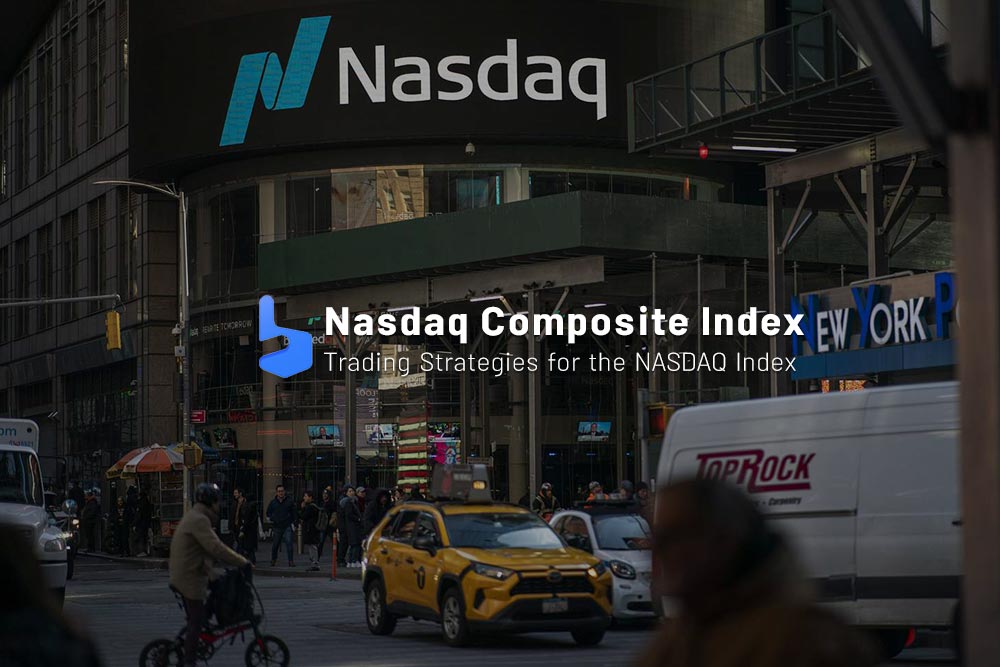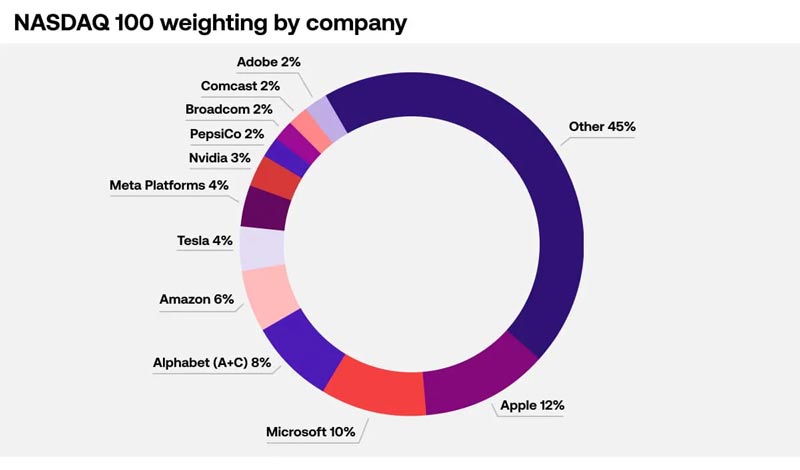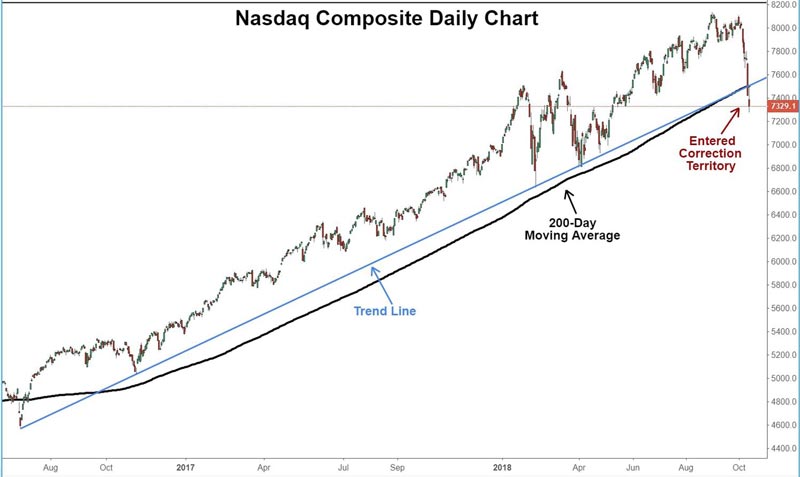What you are about to read:
The NASDAQ Composite Index is one of the most famous indices in the financial world, often associated with technology and growth stocks. Understanding this index is crucial for traders and investors seeking to navigate the dynamic landscape of the stock market. In this article by Brokerland to learn forex trading, we’ll introduce the NASDAQ index, its history, components, and how it influences trading decisions. We’ll also review trading strategies for trading it with Brokerland.
Introduction to the NASDAQ Composite Index
Perhaps the most recognizable name among indices in the trading world after the US Dollar Index is the NASDAQ, which is offered for trading by almost every forex broker, such as USGFX, LiteForex, Alpari, OmegaFinex, Fibo Group, and others. The NASDAQ Composite Index is a stock market index that reflects the performance of a wide spectrum of stocks listed on the NASDAQ stock exchange.
Founded in 1971, it has become synonymous with technology and growth stocks, although it includes companies from various sectors. Unlike some other indices that focus on specific industries or market capitalization levels, the NASDAQ Composite Index encompasses nearly all stocks listed on the exchange, making it a comprehensive measure of market performance.
One notable feature of the NASDAQ Composite Index is its heavy weighting towards technology companies. Tech giants like Apple, Microsoft, Amazon, Meta Platforms (formerly Facebook), Alphabet (Google), and Tesla are among its largest constituents.
However, the index also includes companies from sectors such as healthcare, consumer discretionary, and industrials, reflecting the diverse nature of the NASDAQ exchange. This composition makes this index particularly sensitive to developments in the technology sector and market trends towards growth stocks.
The NASDAQ Composite Index is market-capitalization weighted, meaning that companies with higher market capitalization have a greater impact on its movements. This weighting ensures that changes in the stock prices of larger companies have a more significant effect on the index’s value compared to smaller companies.
As a result, the performance of tech giants like Apple or Microsoft can heavily influence the trajectory of the this index as a whole. This dynamic nature of the index makes it a popular choice for traders and investors seeking exposure to the technology sector or gauging the overall health of the stock market.
In general, the NASDAQ Composite Index plays a significant role as a broader gauge of the stock market, offering insights into the performance of technology, growth, and other sectors listed on the exchange. Its comprehensive coverage, heavy weighting towards technology companies, and market-capitalization weighting methodology make it a valuable tool for traders, investors, and financial analysts, providing a picture of market health and inclination towards growth-oriented stocks.
Components of the NASDAQ Composite Index
The components of the NASDAQ Composite Index represent a diverse spectrum of companies listed on the stock exchange. While the index is heavily weighted towards technology companies, it includes companies from various sectors. Some key components include:
- Technology companies: Technology giants like Apple Inc. (AAPL), Microsoft Corporation (MSFT), Amazon.com Inc. (AMZN), Meta Platforms (formerly Facebook) (FB), Alphabet Inc. (GOOGL), and Intel Corporation (INTC) are among the largest constituents of the index. These companies are leaders in their respective fields, driving innovation and shaping the digital landscape.
- Biotechnology and healthcare: The NASDAQ Composite Index also features prominent biotechnology and healthcare companies, reflecting the importance of this sector in the modern economy. Biotech companies such as Amgen Inc. (AMGN), Gilead Sciences Inc. (GILD), and Biogen Inc. (BIIB) are significant components of the index, contributing to its overall performance.
- Consumer discretionary: Companies in the consumer discretionary sector, which includes businesses offering non-essential goods and services, are also represented in the NASDAQ Composite Index. Retail giants like Amazon.com Inc. (AMZN), which operates both as a technology and retail company, and companies like Tesla, Inc. (TSLA), known for their electric vehicles, fall into this category.
- Financial services: While this Composite Index is not as heavily weighted towards financial services as some other indices, it still includes notable players in this sector. Companies like PayPal Holdings, Inc. (PYPL) and Intuit Inc. (INTU), which provide financial technology solutions, are part of this index.
Additionally, the NASDAQ Composite Index encompasses companies from sectors such as industrials, telecommunications, consumer goods, and others. Examples include Tesla, Inc. (TSLA) in the automotive industry and Zoom Video Communications, Inc. (ZM) in the telecommunications sector.
These are just a few examples of the diverse components that make up the NASDAQ, which, in general, exposes it to a wide range of industries and companies, turning it into a comprehensive measure of the performance of the NASDAQ stock exchange and the US stock market.
Market-Capitalization Weighting in NASDAQ
The NASDAQ Composite Index is effectively market-capitalization weighted. This means that companies listed in the index are weighted based on their market capitalization, which is the total value of a company’s outstanding shares. In a market-capitalization-weighted index like the NASDAQ, companies with higher market capitalization have a greater impact on the index’s movements.
Practically, this means that the largest companies by market capitalization exert a greater influence on this Index. For example, if a company like Apple or Microsoft, with massive market capitalization, experiences a significant increase or decrease in its stock price, it will have a more significant impact on the NASDAQ index compared to a smaller company with lower market capitalization.
The market-capitalization weighting method reflects the relative importance of individual companies in the index, aligning with the notion that larger companies usually have a greater influence on the overall stock market due to their size and reach. As a result, the NASDAQ Composite Index is often regarded as a barometer of the performance of leading technology and growth companies, given their predominant representation and market value in the index.
Trading Strategies for the NASDAQ Composite Index
Trading the NASDAQ Composite Index requires a strategic approach tailored to the unique characteristics and dynamics of the market. While it’s true that for trading any currency pair, index, or cryptocurrency from Ethereum to Bitcoin to Solana and other altcoins, one can employ any preferred strategy such as Smart Money and Scalping, some strategies may be more effective and suitable for each case.
Just as we’ve explored suitable strategies for trading in the Kill Zones or part-time trading in forex, here are some trading strategies commonly used by traders and investors to capitalize on opportunities presented by the NASDAQ Composite Index:
Trend Following: Trend following is a popular strategy among traders aiming to invest in stable price trends in the Index. Traders identify the dominant trend (upward or downward) using technical analysis tools such as moving averages, trendlines, and various forex indicators, particularly momentum indicators like pivot point indicator. They then enter trades in the direction of the trend, buying during uptrends and selling during downtrends. Trend following requires discipline and patience to ride out fluctuations and profit from trends.
Breakout Trading: Breakout trades involve identifying key support and resistance levels on the forex chart and entering trades when the price breaks out of these levels. Breakouts can occur after consolidation periods or range-bound trading and often signal the beginning of a new trend or movement in the market. Traders can use indicators like Bollinger Bands, volatility measures, and volume indicators to confirm breakout signals and effectively manage risk. Care should be taken to watch out for fake breakouts to avoid getting trapped.
Range Trading: Given the NASDAQ Composite Index’s reputation for volatility, some traders specialize in range trading strategies to profit from price oscillations. Options trading, in particular, provides opportunities to invest in volatility by buying options to benefit from price changes or selling options for profit when volatility is high.
Mean Reversion: The goal of mean reversion trading strategies is to capitalize on short-term price reversals or corrections in the NASDAQ Composite Index. Traders identify overbought or oversold conditions using technical indicators like the RSI indicator, stochastic oscillator, or Bollinger Bands. When the index price deviates significantly from its averages or historical levels, traders anticipate a mean reversion and enter contrarian trades to profit from price corrections.
Fundamental Analysis: Investors may employ fundamental analysis to assess the fundamental value and growth outlook of individual companies in the Index. By analyzing factors such as earnings growth, revenue forecasts, inflation rates, competitive positioning, and industry trends, investors can make informed decisions about buying, holding, or selling stocks. Fundamental analysis provides a long-term perspective on investing, focusing on the intrinsic value of companies rather than short-term price movements.
It’s important to note that no trading strategy guarantees success, and traders should carefully evaluate their risk tolerance, investment objectives, and market conditions before implementing any strategy. Additionally, traders may combine multiple strategies, conduct backtesting before use, or test them using a MetaTrader strategy tester and adapt them based on evolving market conditions to optimize their trading approach and achieve their financial goals. Continuous education, risk management, and discipline are key components of successful trading in the NASDAQ index.
Key Factors Affecting NASDAQ Performance
Several key factors influence the performance of the NASDAQ index and shape its movements and direction. Understanding these factors is essential for traders and investors seeking to interpret and predict changes in the index’s value. Here are some of the main factors influencing index performance:
- Technological Innovation: The NASDAQ index places a strong emphasis on technology companies and is particularly sensitive to advancements and innovations in this sector. Developments such as the introduction of new products, innovative technologies, and changes in consumer preferences can significantly impact the performance of technology stocks and, consequently, the NASDAQ index as a whole.
- Economic Indicators: The release of economic data, such as GDP growth, employment figures, unemployment rates, consumer spending, and manufacturing output, plays a crucial role in influencing investor sentiment and market direction, as we discussed in sentimental analysis. Positive economic indicators can increase confidence in corporate earnings outlook and economic growth, support stock prices, and boost the NASDAQ index.
- Interest Rates and Monetary Policy: Policy decisions by central banks, especially the Federal Reserve in the United States, have a significant impact on the index. Changes in interest rates, inflation expectations, and monetary policy stance can affect borrowing costs, corporate profitability, and investor risk appetite, leading to changes in stock prices and market sentiment.
- Market Sentiment and Investor Behavior: Investor sentiment, market psychology, and risk perception also play a significant role in shaping the index performance. Factors such as geopolitical tensions, conflicts, corporate earnings reports, and global events can influence investor sentiment, leading to stock price fluctuations and market volatility.
- Regulatory Environment: Changes in regulatory policies and government interventions can affect specific industries or companies within the index. Regulatory developments related to antitrust, data privacy, intellectual property rights, and environmental regulations can impact business operations, profitability, and market valuations, consequently affecting NASDAQ performance.
- Global Events and Geopolitical Risks: Geopolitical events such as geopolitical tensions, trade negotiations, diplomatic relations, and geopolitical conflicts can create uncertainty and volatility in financial markets. Global economic conditions, currency fluctuations, and international trade dynamics also influence investor sentiment and market performance, impacting the NASDAQ index.
Overall, these key factors interact in complex ways to influence NASDAQ performance. Traders and investors should stay informed about economic developments, market trends, and geopolitical risks to make informed decisions and effectively navigate the dynamic stock market landscape.
Conclusion
The NASDAQ index serves as a vital barometer in the broader stock market, especially for technology and growth-oriented sectors. Traders and investors can leverage their understanding of index components, market dynamics, and trading strategies to navigate the complexities of financial markets and potentially capitalize on profit opportunities.
In this comprehensive article with BrokerLand, we have endeavored to not only introduce the components of the NASDAQ index but also educate you on trading strategies to use it effectively. We hope it has been helpful.












